Thermostatic mixer: how to choose and install a mixer with a thermostat
Double-lever and single-lever faucets are installed on sinks to mix cold and hot water.They are extremely easy to use and cheap.
But when the pressure in the pipes changes, their valves have to be tightened so that the flow temperature returns to the desired parameters. It would be nice to automate this process, wouldn't it?
Modern thermostatic The mixer allows you to eliminate this small but annoying inconvenience. The range of models from various manufacturers is so rich that choosing the right option is quite difficult. Are you having trouble choosing? Or have you decided to install such a mixer yourself, but are you afraid of accidentally breaking something?
We will help you clarify these issues - the article discusses the device, operating principle and existing types of thermostat taps. A step-by-step installation algorithm is also provided.
In addition, we have selected informative photos, visual diagrams and detailed video instructions that will help any beginner choose the best faucet and master the installation process.
The content of the article:
The principle of operation of a household mixer with a thermostat
Changes in pressure and temperature in water supply pipes are an unpleasant situation faced by residents of both apartment buildings and private cottages. This is especially annoying in the mornings, when the stream from the faucet in the washbasin becomes either too hot or too cold.
This happens because everyone in the house at this time begins to intensively use water for washing and bathing. Its consumption increases sharply, causing pressure drops.
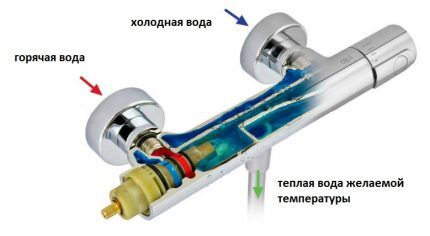
According to domestic standards, temperature DHW in a centralized system it can fluctuate between 50 and 70 degrees. The spread is quite large.
For utility workers This is a blessing; they don’t have to worry too much about going beyond the boundaries of the standards. And consumers are forced to suffer from inconvenience. It is necessary to install special control devices or constantly adjust water supply in the tap.
This is where thermostat mixers come to the rescue, all models of which are divided into three categories:
- Mechanical.
- Electronic.
- Contactless.
The first ones are the simplest and most affordable. They adjust the required temperature and water pressure using a lever or valve, and maintain the specified parameters through pure mechanics and changes in the physical properties of the internal elements of the device.
The second and third ones already contain electronic components that require constant power supply.
Type #1 - devices with mechanical adjustment
The operation of mixers of this type is based on the movement of a movable valve inside the device, which reacts to changes in the parameters of the mixed water jet.
If the pressure in one pipe increases, the cartridge simply moves and reduces the flow of water entering for mixing from the other. As a result, the temperature in spout remains at the same level.
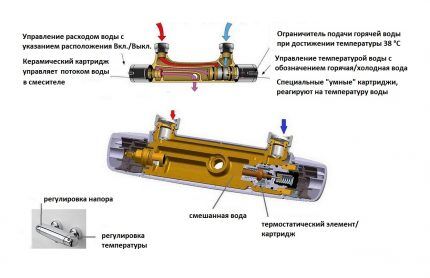
The internal moving valve contains a material that sensitively and quickly reacts to all changes in the temperature of the water entering the mixing device.
In most cases, synthetic wax acts as a sensitive thermoelement sensor. Under the influence of temperature, it contracts and expands, which leads to displacement of the locking cartridge.
Many mechanical models have a fuse on the control valve that limits the maximum temperature to 38 °C.For a person, such indicators are considered the most comfortable.
But even in the absence of a fuse, water from thermostatic the mixer will not leak. Everything is designed so that when the specified temperatures are reached, the wax expands to its maximum, and the valve closes the pipe DHW - fully. Burns from boiling water are excluded here by definition.
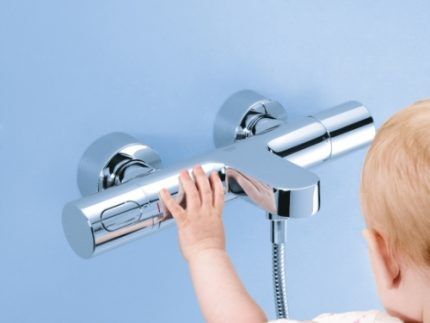
Valve displacement occurs internally almost instantly. Any change in the temperature of the incoming water or its pressure leads to immediate expansion/constriction of the thermoelement.
As a result, even strong fluctuations in flow parameters in pipes DHW And HVS do not affect the general flow in spout. Water will flow from it exclusively at the parameters set by the user.
Some models use bimetallic strips instead of wax. The principle of their operation is similar. Under the influence of temperature, they bend and move the valve to the desired depth.
Type #2 - devices with electronic filling
Faucets with electronic thermostats are more expensive, technically more complex and require power. They are connected to an outlet via a power adapter or contain a battery that must be replaced regularly.
The electronic thermostat is controlled by:
- remote buttons or on the mixer body;
- sensors;
- remote control.
The water levels in this device are monitored using electronic sensors. In this case, all numbers are displayed on a special liquid crystal screen. The display often shows both temperature and pressure. But an option with only one value is also possible.
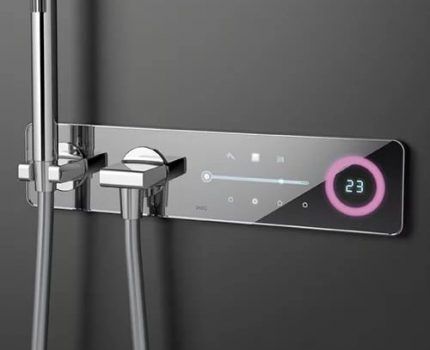
Often in everyday life, an electronic thermostat mixer with a display is a device with excessive functionality. Such equipment is more intended for installation in medical institutions or other public institutions.
It is much more common in showers and toilets in office buildings than in in kitchens or in the bathrooms of private cottages.
However, if construction is planned "smart home" with all sorts of things that make life easier gadgets, then a mixer with an electronic thermostat is just what you need. It definitely wouldn’t hurt in such a home.
In addition to automatically controlling the water temperature for greater comfort in the bathroom, you can install heated floors, so as not to depend on the mood of heat supply organizations during the cold season.
Choosing a thermal mixer for the kitchen and bathroom
The operating principle of all thermostat mixers is similar.Using the adjustment, the required temperature is set once, and then the water supply valve simply opens.
They function the same way, but the model range is quite extensive. And each device has its own individual characteristics and advantages.
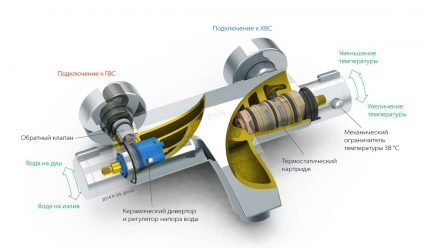
By purpose and installation point thermostatic faucets are divided into four categories:
- for washing in the kitchen;
- with spout exclusively for washbasin;
- for bidet;
- With shower head and spout for Bath.
They are installed on a wall, countertop or plumbing fixture using an open mounting method. Or they are mounted in a closed way, when only the valves or levers and spout remain visible. And with this installation, all internal parts are hidden behind the cladding on the wall.
Most often, thermostatic mixers are installed in the bathroom. They are not so popular in the kitchen. The temperature of the water in the kitchen sink has to be constantly changed - either cold for drinking or filling the kettle, warm for washing food, or hot for washing dishes.
Continuously switching the thermocouple setting is not recommended. And the convenience of having it thermostatic The mixer is reduced in this case to almost zero. And in the shower and washbasin the temperature is precisely what is required. Here it is more relevant.
Pros and cons of different models
Mechanical faucets with a thermostat integrated into the body are more reliable than their electronic counterparts. They will cost less than their counterparts. And if they break down, they are easier to repair.
But models with a display are more accurate and easier to operate. But if they malfunction, they can only be repaired in a specialized center.
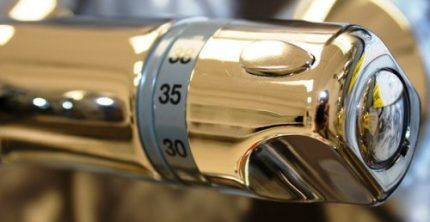
Electronic devices are adjustable smoothly, allowing you to specify any parameters in the settings within the operating range for a particular model. However, they require power supply. If there are power failures, there is a risk of not only being left without electricity, but also losing water supply.
Water mixers for domestic needs with thermostat:
- provide the required pressure with a stable temperature;
- completely safe to use;
- reduce waste of water;
- easy to install with your own hands;
- prevent scalding and exposure to ice showers;
- save energy (if installed in an autonomous hot water supply system).
Their only drawback is their high cost. However, in return - comfort, savings and safety.
What to look for when choosing?
The material for making the mixer body should be chosen carefully:
- bronze, copper or brass – the most durable and expensive;
- ceramics – not as reliable as metal, but looks more attractive;
- silumin (aluminum-silicon alloy) - cheap and short-lived;
- plastic – the lowest price and low reliability.
It is even more important to select the correct thermostat shutoff valve material. Leather and rubber options are cheap, but wear out fairly quickly. If solid suspensions get into the water tap, these gaskets can quickly fail.
Compared to a conventional mixer, their wear rate is thermostatic analogue is an order of magnitude higher.It won’t take long for things to end up in a flood and a showdown with the neighbors below.
It is best to choose valves made of high-strength ceramics. They themselves are durable and will not damage the saddle.
But if the mixing device is installed with them, then you should forget about using force when tightening the valve all the way. The valve is unlikely to break, but the thermostat head will be torn off quickly.

The main problem with most faucets with thermostats is the differences in the standard wiring diagrams for hot and cold water pipes in Russia and Europe.
We have a pipeline DHW According to the standard, it is connected to the plumbing fixture on the right, while theirs is on the left. However, these devices were mainly developed and produced by European manufacturers, according to their rules.
When choosing thermostatic faucet, it is extremely important to find out from the seller the diagram for connecting water pipes to it. If the pipes are connected the other way around, the thermostat will simply break.
Devices for bathtubs and bidets must be adapted to Russian standards. Otherwise, you will have to change the configuration of the pipes, and this will be additional serious costs.
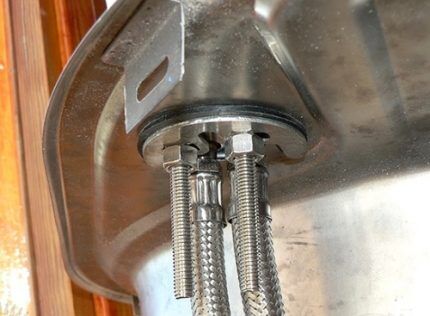
And the last point is the presence of sufficient pressure in the water supply. In passports thermostatic mixers indicate a minimum operating pressure of 0.5 bar.
If it actually turns out to be lower in the pipes, then the device will not be able to work properly.There is simply no point in installing it in such a water supply system.
Leaders in the production of thermal mixers
When choosing a thermostat mixer, preference should be given to models made specifically for Russia.
Foreign manufacturers have recently begun to produce this plumbing fixtures to meet domestic standards and requirements. This is exactly what you should look for in stores, so as not to rack your brains later when performing installation.
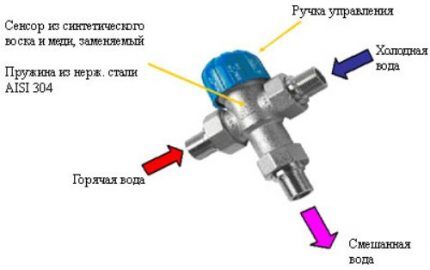
On the domestic market, mixers with a built-in thermostat are presented as follows: brands:
- Oras (Finland);
- Cesares And Gattoni (Italy);
- Grohe, Kludi, Vidima And Hansa (Germany);
- Lemark (Denmark);
- Toto (Japan);
- NSK (Türkiye);
- Iddis And SMARTsant (Russia).
The Germans are the undoubted leaders in this industry. But other manufacturers are also trying to keep up, creating lines of different price classes.
Here you need to focus more on the materials of manufacture and the design of the product. However, one should not forget about the positive image gained over the years.
Installation of a mixing tap with thermostat
In general, the installation of the mixer in question is practically no different from installations similar to the conventional design without thermostat. You just need to be careful with the hot and cold water connection points to the device. Confusion will inevitably lead to thermostat failure.
If you cannot unfold the mixer for proper connection, you will have to swap the supply pipelines. The easiest way to do this is with flexible hoses. But it may be necessary to rebuild the wiring of the water supply system in the immediate vicinity of the faucet being installed.
The installation procedure is as follows:
- The supply of hot and cold water at the riser is cut off.
- The existing crane is dismantled.
- Eccentric discs are installed on the pipes and positioned for the new mixer.
- Gaskets and decorative elements are installed in their designated places.
- The mixer with thermostat is screwed on.
- Mounted parts (spout, watering can).
- The water is turned on, and then the functionality of the installed device is checked.
- The temperature of the water coming from the thermostat mixer is adjusted.
To prevent leaks, tow, FUM tape or another analogue is used as a sealant.
Coarse filters and check valves must be installed on the water supply. Thermostatic The mixer is quite demanding on the quality of the water entering it.
On the one hand, care should be taken to ensure that there is no silt or other deposits in the flow, and on the other hand, even potential cross-flow between pipes should be excluded HVS And DHW. This fittings need not be installed only in one case, if it is already located in the housing of the mixing device.
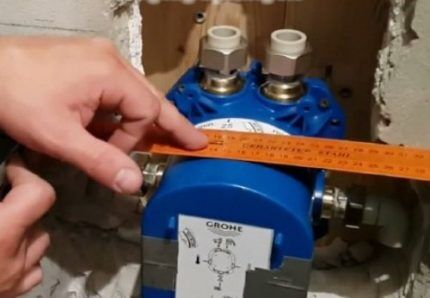
When installed hidden in the wall, only the spout and the buttons or thermostat adjustment lever remain visible. Everything else is covered with decor. The bathroom takes on a finished look. Just an ideal option, but if the mixer breaks down, you will have to break the walls and remove the tiles to repair it.
The thermostat is calibrated using a special adjusting screw or valve under the protective cover of the device. To do this you will need a regular thermometer and a screwdriver.
If the thermostat is not calibrated in accordance with the passport instructions, then the temperatures at the mixer valve and in reality can vary greatly.
Do you love original bathroom solutions? Then you may be interested in the information about the waterfall faucet reviewed In this article.
Conclusions and useful video on the topic
Review of a mixing tap with a thermostat in the bathroom:
How the thermostat mixer works:
Step by step installation guide thermostatic mixer GROHE:
Advantages thermostatic mixer mass. The main obstacle to its mass use is the high cost of this device for many Russians.
A regular faucet with a mixing chamber without a thermostat will cost several times less. But if comfort and safety are more important to you, then equipment with a built-in thermostat is worth the investment.
Do you use a thermostatic mixer? Perhaps you installed it yourself? Please share your impressions of using such a smart device - what disadvantages you discovered for yourself, and what pleases you most.
Or are you just choosing a mixer model for yourself? Or maybe you encountered difficulties during the installation process - ask your questions in the comments section, and we will try to help you.




Just recently I had a question about choosing a bathroom faucet. I immediately went to a plumbing store.They didn’t tell me anything useful there, since they don’t have very educated people working on their team. I decided to find a solution to my answer on the Internet. Quite by accident I came across this Internet resource, surfed through it and in the end I bought a mechanical thermostatic mixer. Everything is working well now.
How to establish “friendship” between a thermostatic mixer and a double-circuit gas boiler? In this pair, the mixer works perfectly, and the boiler constantly starts.
Well, they should interact normally anyway; in theory, no problems should arise. If it starts to cycle, then you can try to set the temperature on the boiler closer to the maximum and gradually reduce it until it starts working normally. Although I don’t quite understand why you even need this thermostat on the faucet. For me it's not the most convenient thing.
If, when using a “thermostatic mixer” with hot water received from a “gas boiler”, the combustion is turned off and then the “gas boiler” is ignited (clocked) again, then the “thermostatic mixer” structurally performs the function of maintaining the set temperature of the water leaving the consumer by changing hot water flow.
1.0. When the temperature of the water leaving the consumer increases, the “thermostatic mixer” reduces the flow of hot water coming from the “gas boiler” and the “gas boiler” turns off.
1.1.As a result of turning off the “gas boiler”, the temperature of the hot water supplied from the “gas boiler” to the “thermostatic mixer” decreases and the temperature of the water leaving the consumer decreases, the “thermostatic mixer” increases the flow of hot water coming from the “gas boiler” and the “gas boiler” is turned on.
1.2. As a result of turning on the “gas boiler”, the temperature of the hot water supplied from the “gas boiler” to the “thermostatic mixer” increases and the temperature of the water leaving the consumer increases, the “thermostatic mixer” reduces the flow of hot water coming from the “gas boiler” and the “gas boiler” turns off.
Further, constantly alternating again, situations 1.1, 1.2, 1.1, 1.2, ... are repeated sequentially to infinity.
To use a “thermostatic mixer” with hot water obtained from a “gas boiler”, it is necessary to use a “thermostatic mixer”, which structurally performs the function of maintaining a given temperature of the water leaving the consumer by changing the flow of cold water.
When working with a “gas boiler”, the “thermostatic mixer” must change the flow of cold water, but not the water coming from the “gas boiler”.
We bought a thermal mixer (with mechanical adjustment) on the advice of salespeople in a store for a lot of money. After installation, either boiling water or cold water was supplied. The plumber, not particularly educated, immediately said “dismantle the device and install a regular mixer.”
We don't know what to do. Can this be configured manually? There are probably no plumbers who understand such devices. What can you do in this situation?
If, when using a “thermostatic mixer”, the temperature of the water leaving the consumer is sometimes cold and sometimes hot, and this happens on the same “thermostatic mixer” arbitrarily, then the supply connection to the “thermostatic mixer” is done the other way around, the cold inlet is supplied hot water, and cold water is supplied to the hot inlet.
If the “thermostatic mixer” is connected incorrectly:
1.1. When the temperature of the water leaving the consumer is reduced, the “thermostatic mixer” seeks to reduce the flow of incoming cold water, but hot water is supplied to the cold water inlet and, as a result, the “thermostatic mixer” reduces its flow, reducing the temperature of the water leaving the consumer, and the “thermostatic mixer” continues to reduce the flow of the cold inlet to which hot water is supplied as a result of incorrect connection. Therefore, only cold water continues to flow from the “thermostatic mixer”.
1.2. When the temperature of the water leaving the consumer increases, the “thermostatic mixer” tends to reduce the flow of incoming hot water, but cold water is supplied to the hot water inlet and, as a result, the “thermostatic mixer” reduces its flow, increasing the temperature of the water leaving the consumer, and the “thermostatic mixer” continues to reduce the flow of the hot inlet to which cold water is supplied as a result of incorrect connection. Therefore, only hot water continues to flow from the “thermostatic mixer”.
When connected correctly:
1.0.When the temperature of the water leaving the consumer increases, the “thermostatic mixer” increases the flow of cold water entering the cold water inlet, so the temperature of the water leaving the consumer reaches the set temperature. When reducing the temperature of the water leaving the consumer, the “thermostatic mixer” reduces the flow of cold water entering the cold water inlet, so the temperature of the water leaving the consumer comes to the set temperature.
or
1.0. When the temperature of the water leaving the consumer increases, the “thermostatic mixer” reduces the flow of hot water entering the hot water inlet, so the temperature of the water leaving the consumer reaches the set temperature. When the temperature of the water leaving the consumer decreases, the “thermostatic mixer” increases the flow of hot water entering the hot water inlet, so the temperature of the water leaving the consumer reaches the set temperature.
or
1.0. When the temperature of the water leaving the consumer increases, the “thermostatic mixer” reduces the flow of hot water entering the hot water inlet and increases the flow of cold water entering the cold water inlet, so the temperature of the water leaving the consumer comes to the set temperature. When the temperature of the water leaving the consumer decreases, the “thermostatic mixer” reduces the flow of cold water entering the cold water inlet and increases the flow of hot water entering the hot water inlet, so the temperature of the water leaving the consumer comes to the set temperature.
If the supply of cold and hot water to the “thermostatic mixer” is incorrectly connected, then only cold or only hot water will flow from it for the consumer, randomly.
They didn’t want to stage it before, they thought it was pampering for a lot of money. But they gave us a Lemark for our bath. This is such comfort! Now we want to put it on the sink and sink. By the way, it also saves water while you wash your hands or dishes, wait until the hot water flows and heats up, then adjust it with the cold one. And with thermo it takes 2-3 seconds and the temperature stays right away.
Hello ! I bought a thermal mixer for the bathroom from Grohe in Leroy Merlin. The sales consultant did not say anything about the fact that the thermal mixers are made to European standards for hot water supply and hot water supply. The plumbers whom I called from the Zhilishchnik-Presnya State Budgetary Institution also, without hesitation, connected the thermal mixer as taught, took the money and did not They cleaned up after themselves and left. Now I have either hot or cold water flowing. I called Leroy Merlin - they connected me with the plumbing department in the Lefortovo shopping center - I reported the problem, they immediately told me that I have hot water supply and hot water supply according to Russian standards and not vice versa as required for thermomixer. I thanked you for the timely information and asked: what should I do now? They suggested a plumber who works with their clients. The plumber looked at my photos - I have hot water and hot water pipes inside the wall under the tiles and said that he was very sorry for me, but alas, he couldn’t help me, because there was no solution, change the water supply pipes in some places it is impossible. QUESTION: is there an engineering solution in which it is not necessary to dismantle the entire house down to the foundation and can you help with this?